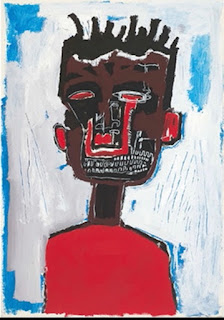Identity Biography and Fame
Andy Warhol and Jean-Michel Basquiat were prevalent artists to make noise in the art world. They valued fame and success, which reflects in their artwork. Warhol's work specifically centered around celebrity and consumerist culture. Using silk screen to create repetition and perfect recreation of iconic everyday objects (like Campbell's soup can) and celebrities (like Marylin Monroe and Elvis). Basquiat also had a strong interest in fame. His mother took him to museums at a young age exposing him to the arts. This grew as Basquiat became influenced by musicians and philosophers alike. In his work, unlike warhol, his recreation of icons and pop culture moments were “exploded” and emphasized. He stripped the original forms but not like the blocking of cubism the art world had come to know. Andy Warhol once said to him “ that's why you’re better than me, you're faster”. I would personally go as far as to say that Andy didn't mean he just admired his speed, but that Basquiat could recreate something so instinctively and effortlessly. Warhol was known to hate and struggle with drawing, and his own silk screen works were more direct copies of the subject. Basquiat created something new, something familiar but with more context. He once said “ influence is ideas going through a new mind.” (Radiant child)
Basquiat was described as painting ‘child-like’ not as an insult, but to explain how he doesn’t create based on the likeness of the image but based on the subject. As John Berger puts it, “Seeing comes before words. The child looks and recognizes before it can speak''. This ability to return to the identifying skills of a child, while maintaining his extensive understanding of the arts, history, and anatomy set Basquiat apart.
Both artists come from different backgrounds, Warhol was a sick kid who was often stuck in bed, leading to a lot of isolation where he started making art. His parents were working-class immigrants, which most likely began his interest in fame, as well as an awareness of how american consumerism took over culturally, right at the formative years or capitalistic monopoly. Basquiat's father was hatian and a white collar worker. Basquiat was eager to please his father and prove he was successful. His Puerto Rican mother encouraged trilingual fluency and education in the arts. He ran away from home at 17 and joined a community of underground like minded creatives. He lived in extreme poverty, he couldn't be working a regular job because of how inhumanely the working-class, especially as a black man, are treated. Even as a successful and famous artist, when he walked out of that environment, he was not recognized and subject to racism as any black man would be. This greatly influenced Basquiat's artwork, creating heavy themes on racial identity.
I think that both artists became synonymous with their work. Andy Warhol focused on celebrity more specifically the consumerism of celebrity becoming more symbol that person. Warhol became and is to this day, very famous, his work is in itself a pop culture reference, and even during his own life became (both intentionally and as a result of fame) consumed by the masses. Basquiat began as a graffiti artist writing provoking messages everywhere. His transition to canvas and paper was unconventional and never tidy enough for the sterile museum and gallery walls of the high art world. But this in itself is a reflection of the artist; provocative and unconventional. Basquiat died very young, however his work is still making headlines to this day.
Citation
Arthouse Films, Curiously Bright Entertainment & LM Media Gmbh; produced by David Koh ... [and others] ; a film by Tamra Davis ; produced & directed by Tamra Davis. Jean-Michel Basquiat : The Radiant Child. [New York] :Distributed by New Video, 2010.
Berger, John. Ways of seeing. Penguin Classics, 2008.
Andy Warhol slideshow. California State University, November 2, 2010
Andy Warhol: A Documentary Film. 2006. [video] Ric Burns.
“There is the conscious and unconscious, private and public, civilized and base, good and bad, and we can create ourselves as well-rounded beings from the management of these seemingly opposed elements. Thus we are shaped by the circumstances of birth and have no control over our parentage, but we can, if we desire, make ourselves in our own image by employing the wide range of products and services designed for self-enhancement that are available in the consumer marketplace.” (126) i picked this quote because I wonder if this is truly a result of consumerism or an innate human desire.
“Underscoring this association of identity with appearance is a cultural anxiety about knowing who it is we are encountering. Using coded items of clothing to make such categorizations more visible also makes them a site for playful resistance.” (128) people use clothing tattoos piercings jewelry etc to both feel that we are displaying a certain identity and to communicate it with others.




No comments:
Post a Comment